Search results for: 'All'
-
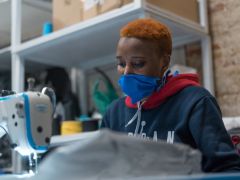 D-2388 What’s the Best Material for a Mask?
D-2388 What’s the Best Material for a Mask?Federal health officials have now recommended that we cover our faces with fabric during the coronavirus pandemic. But what material offers the most protection?
The Centers for Disease Control and Prevention has posted a no-sew mask pattern using a bandanna and a coffee filter as well as a video on making masks using rubber bands and folded fabrics found at home.
While a simple face covering can reduce the spread of coronavirus by blocking outgoing germs from coughs or sneezes of an infected person, experts say there is more variation in how much homemade masks might protect the wearer from incoming germs, depending on the fit and quality of the material used.
Scientists around the country have taken it upon themselves to identify everyday materials that do a better job of filtering microscopic particles. In recent tests, HEPA furnace filters scored well, as did vacuum cleaner bags, layers of 600-count pillowcases and fabric similar to flannel pajamas. Stacked coffee filters had medium scores. Scarves and bandanna material had the lowest scores, but still captured a small percentage of particles.
If you don’t have any of the materials that were tested, a simple light test can help you decide whether a fabric is a good candidate for a mask.
“Hold it up to a bright light,” said Dr. Scott Segal, chairman of anesthesiology at Wake Forest Baptist Health who recently studied homemade masks. “If light passes really easily through the fibers and you can almost see the fibers, it’s not a good fabric. If it’s a denser weave of thicker material and light doesn’t pass through it as much, that’s the material you want to use.”
Researchers say it’s important to remember that lab studies are conducted under perfect conditions with no leaks or gaps in the mask, but the test methods give us a way to compare materials. And while the degree of filtration for some homemade masks seems low, most of us — who are staying home and practicing social distancing in public — don’t need the high level of protection required for medical workers. More important, any face covering is better than none, especially if worn by a person who has the virus but doesn’t know it.
The biggest challenge of choosing a homemade mask material is to find a fabric that is dense enough to capture viral particles, but breathable enough that we can actually wear it. Some items being touted online promise high filtration scores, but the material would be unwearable.
Dressing Up for Work … at Home
Yang Wang, an assistant professor of environmental engineering at Missouri University of Science and Technology, worked with his graduate students to study various combinations of layered materials — including both air filters and fabric. “You need something that is efficient for removing particles, but you also need to breathe,” said Dr. Wang, who last fall won an international award for aerosol research.To test everyday materials, scientists are using methods similar to those used to test medical masks, which everybody agrees should be saved for medical workers who are exposed to high doses of virus from seeing infected patients. The best medical mask — called the N95 respirator — filters out at least 95 percent of particles as small as 0.3 microns. By comparison, a typical surgical mask — made using a rectangular piece of pleated fabric with elastic ear loops — has a filtration efficiency ranging from 60 to 80 percent.
Dr. Wang’s group tested two types of air filters. An allergy-reduction HVAC filter worked the best, capturing 89 percent of particles with one layer and 94 percent with two layers. A furnace filter captured 75 percent with two layers, but required six layers to achieve 95 percent. To find a filter similar to those tested, look for a minimum efficiency reporting value (MERV) rating of 12 or higher or a microparticle performance rating of 1900 or higher.
The problem with air filters is that they potentially could shed small fibers that would be risky to inhale. So if you want to use a filter, you need to sandwich the filter between two layers of cotton fabric. Dr. Wang said one of his grad students made his own mask by following the instructions in the C.D.C. video, but adding several layers of filter material inside a bandanna.
Dr. Wang’s group also found that when certain common fabrics were used, two layers offered far less protection than four layers. A 600 thread count pillow case captured just 22 percent of particles when doubled, but four layers captured nearly 60 percent. A thick woolen yarn scarf filtered 21 percent of particles in two layers, and 48.8 percent in four layers. A 100 percent cotton bandanna did the worst, capturing only 18.2 percent when doubled, and just 19.5 percent in four layers.
The group also tested Brew Rite and Natural Brew basket-style coffee filters, which, when stacked in three layers, showed 40 to 50 percent filtration efficiency — but they were less breathable than other options.
If you are lucky enough to know a quilter, ask them to make you a mask. Tests performed at the Wake Forest Institute for Regenerative Medicine in Winston-Salem, N.C., showed good results for homemade masks using quilting fabric. Dr. Segal, of Wake Forest Baptist Health, who led the study, noted that quilters tend to use high-quality, high-thread count cotton. The best homemade masks in his study were as good as surgical masks or slightly better, testing in the range of 70 to 79 percent filtration. Homemade masks that used flimsier fabric tested as low as 1 percent filtration, Dr. Segal said.
The best-performing designs were a mask constructed of two layers of high-quality, heavyweight “quilter’s cotton,” a two-layer mask made with thick batik fabric, and a double-layer mask with an inner layer of flannel and outer layer of cotton.
Bonnie Browning, executive show director for the American Quilter’s Society, said that quilters prefer tightly woven cottons and batik fabrics that stand up over time. Ms. Browning said most sewing machines can handle only two layers of fabric when making a pleated mask, but someone who wanted four layers of protection could wear two masks at a time.
Ms. Browning said she recently reached out to quilters on Facebook and heard from 71 people who have made a combined total of nearly 15,000 masks. “We quilters are very much in the thick of what’s going on with this,” said Ms. Browning, who lives in Paducah, Ky. “One thing most of us have is a stash of fabric.”
People who don’t sew could try a folded origami mask, created by Jiangmei Wu, assistant professor of interior design at Indiana University. Ms. Wu, who is known for her breathtaking folded artwork, said she began designing a folded mask out of a medical and building material called Tyvek, as well as vacuum bags, after her brother in Hong Kong, where mask wearing is common, suggested it. (DuPont, the maker of Tyvek, said in a statement that Tyvek is intended for medical apparel, not masks.) The folded mask pattern is free online, as is a video demonstrating the folding process. In tests at Missouri University and University of Virginia, scientists found that vacuum bags removed between 60 percent and 87 percent of particles. But some brands of vacuum bags may contain fiberglass or are harder to breathe through than other materials, and shouldn’t be used. Ms. Wu used a bag by EnviroCare Technologies, which has said it does not use fiberglass in its paper and synthetic cloth bags.
“I wanted to create an alternative for people who don’t sew,” said Ms. Wu, who said she is talking to various groups to find other materials that will be effective in a folded mask. “Given the shortage of all kinds of materials, even vacuum bags might run out.”
The scientists who conducted the tests used a standard of 0.3 microns because that is the measure used by the National Institute for Occupational Safety and Health for medical masks.
Linsey Marr, a Virginia Tech aerosol scientist and an expert in the transmission of viruses, said the certification method for respirators and HEPA filters focuses on 0.3 microns because particles around that size are the hardest to catch. While it seems counterintuitive, particles smaller than 0.1 microns are actually easier to catch because they have a lot of random motion that makes them bump into the filter fibers, she said.
“Even though coronavirus is around 0.1 microns, it floats around in a wide range of sizes, from around 0.2 to several hundred microns, because people shed the virus in respiratory fluid droplets that also contain lots of salts and proteins and other things,” said Dr. Marr. “Even if the water in the droplets fully evaporates, there’s still a lot of salt and proteins and other gunk that stays behind as solid or gel-like material. I think 0.3 microns is still useful for guidance because the minimum filtration efficiency will be somewhere around this size, and it’s what NIOSH uses.”
Learn More -
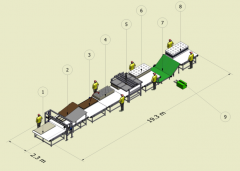 K-5013 HOTMELT GLUING MATTRESS PRODUCTION LINE 2200mm 350 TO 400 MATTRESSES PER 8-HOUR SHIFTREFERENCE NUMBER: K-5013 HOTMELT GLUING MATTRESS PRODUCTION LINE 2200mm 350 TO 400 MATTRESSES PER 8-HOUR SHIFT MAXIMUM WORKING WIDTH: 2200mm CAPACITY: AVERAGE OF 350 TO 400 MATTRESSES (IF OPERATORS WORK WITH AVERAGE EFFICIENCY); TWO LAYERS FOR EACH PANEL ARE GLUED. IN THE FIRST BRIDGE THERE ARE 5 HOTMELT GUNS IN TOTAL: 2 GUNS FOR THE EDGE GLUING 3 GUNS FOR THE CENTER GLUING ONE OF THE 2 EDGE GUNS HAS 8 NOZZLES (T-SHAPE) THE OTHER GUN HAS 4 NOZZLES THE THREE GUNS FOR CENTER GLUING CAN MOVE PNEUMATICALLY (ZIG-ZAG, ARC SHAPE) FELT-TO-FOAM BONDING THE MANUAL GLUING UNIT HAS 2 SPRAY GUNS WITH SEPARATE, 5-METER-LONG PIPES FLOOR SPACE DIMENSIONS: 19300mm X 2300mm ALL THE GLUING MACHINES ARE ABLE TO WORK WITH ANY KIND OF MATTRESS SIMPLY CHOOSE THE MATTRESS TYPE AND THE PARAMETERS ARE SET AUTOMATICALLY QUANTITY AVAILABLE: 1 Learn More
K-5013 HOTMELT GLUING MATTRESS PRODUCTION LINE 2200mm 350 TO 400 MATTRESSES PER 8-HOUR SHIFTREFERENCE NUMBER: K-5013 HOTMELT GLUING MATTRESS PRODUCTION LINE 2200mm 350 TO 400 MATTRESSES PER 8-HOUR SHIFT MAXIMUM WORKING WIDTH: 2200mm CAPACITY: AVERAGE OF 350 TO 400 MATTRESSES (IF OPERATORS WORK WITH AVERAGE EFFICIENCY); TWO LAYERS FOR EACH PANEL ARE GLUED. IN THE FIRST BRIDGE THERE ARE 5 HOTMELT GUNS IN TOTAL: 2 GUNS FOR THE EDGE GLUING 3 GUNS FOR THE CENTER GLUING ONE OF THE 2 EDGE GUNS HAS 8 NOZZLES (T-SHAPE) THE OTHER GUN HAS 4 NOZZLES THE THREE GUNS FOR CENTER GLUING CAN MOVE PNEUMATICALLY (ZIG-ZAG, ARC SHAPE) FELT-TO-FOAM BONDING THE MANUAL GLUING UNIT HAS 2 SPRAY GUNS WITH SEPARATE, 5-METER-LONG PIPES FLOOR SPACE DIMENSIONS: 19300mm X 2300mm ALL THE GLUING MACHINES ARE ABLE TO WORK WITH ANY KIND OF MATTRESS SIMPLY CHOOSE THE MATTRESS TYPE AND THE PARAMETERS ARE SET AUTOMATICALLY QUANTITY AVAILABLE: 1 Learn More -
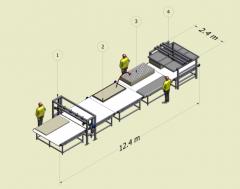 K-5003 HOTMELT GLUING MATTRESS PRODUCTION LINE 2200mm 500 TO 600 MATTRESSES PER 8-HOUR SHIFTREFERENCE NUMBER: K-5003 HOTMELT GLUING MATTRESS PRODUCTION LINE 2200mm 500 TO 600 MATTRESSES PER 8-HOUR SHIFT MAX WORKING WIDTH: 2200mm CAPACITY: AVERAGE 500 TO 600 MATTRESSES PER 8 HOUR SHIFT (DEPENDING ON THE OPERATOR PERFORMANCE), ASSUMING ONLY ONE FOAM LAYER IS USED. THE OVERALL SYSTEM IS CONTROLLED WITH ONE MAIN CONTROL PANEL INCLUDES TWO HOTMELT GLUE GUNS FOR THE EDGE: ONE GUN WITH 8 NOZZLES (T-SHAPED) ONE GUN WITH 4 NOZZLES LINE IS FOR BOTH POCKET AND BONNEL SPRINGS. ONE BUTTON PRESS TOGGLES BETWEEN THE TWO; ALL GLUING DIMENSIONS WILL BE SET AUTOMATICALLY WITHOUT ENTERING ANY DIMENSIONS. FLOORSPACE DIMENSIONS: 12400mm X 2400mm QUANTITY AVAILABLE: 1 Learn More
K-5003 HOTMELT GLUING MATTRESS PRODUCTION LINE 2200mm 500 TO 600 MATTRESSES PER 8-HOUR SHIFTREFERENCE NUMBER: K-5003 HOTMELT GLUING MATTRESS PRODUCTION LINE 2200mm 500 TO 600 MATTRESSES PER 8-HOUR SHIFT MAX WORKING WIDTH: 2200mm CAPACITY: AVERAGE 500 TO 600 MATTRESSES PER 8 HOUR SHIFT (DEPENDING ON THE OPERATOR PERFORMANCE), ASSUMING ONLY ONE FOAM LAYER IS USED. THE OVERALL SYSTEM IS CONTROLLED WITH ONE MAIN CONTROL PANEL INCLUDES TWO HOTMELT GLUE GUNS FOR THE EDGE: ONE GUN WITH 8 NOZZLES (T-SHAPED) ONE GUN WITH 4 NOZZLES LINE IS FOR BOTH POCKET AND BONNEL SPRINGS. ONE BUTTON PRESS TOGGLES BETWEEN THE TWO; ALL GLUING DIMENSIONS WILL BE SET AUTOMATICALLY WITHOUT ENTERING ANY DIMENSIONS. FLOORSPACE DIMENSIONS: 12400mm X 2400mm QUANTITY AVAILABLE: 1 Learn More -
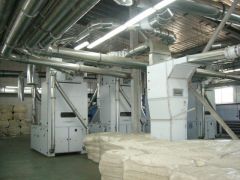 G-7566 TRUTZSCHLER WASTE RECOVERY PLANT YEAR 2004REFERENCE NUMBER: G-7566 TRUTZSCHLER WASTE RECOVERY PLANT YEAR 2004 TRUTZSCHLER & LTG SUBJECT TO PRIOR SALE: ALL MACHINES MADE IN YEAR 2004. EXCELLENT CONDITION. PLANT IS DESIGNED FOR PROCESSING OF COTTON WASTE FROM MILLS OR COTTON GINNING MOTES, CLEANING CAPACITY UP TO 80%, WITH A SUCTION CAPACITY OF 1500 KG / HOUR. QUANTITY AVAILABLE: 1 Learn More
G-7566 TRUTZSCHLER WASTE RECOVERY PLANT YEAR 2004REFERENCE NUMBER: G-7566 TRUTZSCHLER WASTE RECOVERY PLANT YEAR 2004 TRUTZSCHLER & LTG SUBJECT TO PRIOR SALE: ALL MACHINES MADE IN YEAR 2004. EXCELLENT CONDITION. PLANT IS DESIGNED FOR PROCESSING OF COTTON WASTE FROM MILLS OR COTTON GINNING MOTES, CLEANING CAPACITY UP TO 80%, WITH A SUCTION CAPACITY OF 1500 KG / HOUR. QUANTITY AVAILABLE: 1 Learn More -
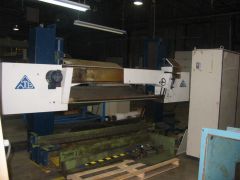 K-8728 BAUMER FOAM CUTTER BSV-R YEAR 1983REFERENCE NUMBER: K-8728 BAUMER FOAM CUTTER BSV-R YEAR 1983 SMALL LOOP (HEAD, PANEL, CONVEYORBELT, ROLLERS) BAUMER BSV-R, 1983, FAB # 4150 IT IS ALL DISMANTLED AND WE DON'T HAVE ANY FRAME WORK FOR THE LOOP BUT WE HAVE ROLLERS THAT CAME OUT OF IT. QUANTITY AVAILABLE: 1 Learn More
K-8728 BAUMER FOAM CUTTER BSV-R YEAR 1983REFERENCE NUMBER: K-8728 BAUMER FOAM CUTTER BSV-R YEAR 1983 SMALL LOOP (HEAD, PANEL, CONVEYORBELT, ROLLERS) BAUMER BSV-R, 1983, FAB # 4150 IT IS ALL DISMANTLED AND WE DON'T HAVE ANY FRAME WORK FOR THE LOOP BUT WE HAVE ROLLERS THAT CAME OUT OF IT. QUANTITY AVAILABLE: 1 Learn More -
 M-5167 SULZER P7300 RR PROJECTILE WEAVING LOOMS
M-5167 SULZER P7300 RR PROJECTILE WEAVING LOOMSREFERENCE NUMBER: M-5167 (1212595FG11RC)
SULZER P7300 RR PROJECTILE WEAVING LOOMSMAKE: SULZER
MODEL: P7300 RR
WORKING WIDTH : 390mm
YEAR: 2004ACCESSORIES WITH ALL 6 LOOMS
BIG LOT OF SPARE PARTS INCLUDE MECHANICAL SPARES AND ELECTRICAL CARDSQUANTITY AVAILABLE: 6
Learn More -
 TT-8285 POWER BARGE, 16.2MW EACH (TOTAL 120MW), YEAR 1998, 50HzTT-8285 POWER BARGE, 16.2MW EACH (TOTAL 120MW), YEAR 1998, 50Hz TECHNICAL DETAILS LIKE LENGTH, WIDTH, DEPTH OF THE BARGE: L= 96540mm, B= 30480mm DEPTH = 6090mm YEAR OF BUILT: 1998 SINGLE BARGE: YES Learn More
TT-8285 POWER BARGE, 16.2MW EACH (TOTAL 120MW), YEAR 1998, 50HzTT-8285 POWER BARGE, 16.2MW EACH (TOTAL 120MW), YEAR 1998, 50Hz TECHNICAL DETAILS LIKE LENGTH, WIDTH, DEPTH OF THE BARGE: L= 96540mm, B= 30480mm DEPTH = 6090mm YEAR OF BUILT: 1998 SINGLE BARGE: YES Learn More -
 TT-8178 TETRA PAK FILLING MACHINE A3 FLEX 7500 BPH, YEAR 2016TT-8178 TETRA PAK FILLING MACHINE A3 FLEX 7500 BPH, YEAR 2016 1. BRAND: TETRA PAK® 2. MODEL: A3FLEX 3. YEAR: 2016 4. SPEED: 7500 BPH 5. PRODUCTS: DAIRY, JUICE 6. CONTAINERS: BRIK Learn More
TT-8178 TETRA PAK FILLING MACHINE A3 FLEX 7500 BPH, YEAR 2016TT-8178 TETRA PAK FILLING MACHINE A3 FLEX 7500 BPH, YEAR 2016 1. BRAND: TETRA PAK® 2. MODEL: A3FLEX 3. YEAR: 2016 4. SPEED: 7500 BPH 5. PRODUCTS: DAIRY, JUICE 6. CONTAINERS: BRIK Learn More -
 TT-8152 SHINOHARA 52-4, SIZE 370 X 520mm, 4 COLORS, YEAR 2002TT-8152 SHINOHARA 52-4, SIZE 370 X 520mm, 4 COLORS, YEAR 2002 1. SHINOHARA 52-4 2. FOUR COLORS 3. SIZE 370 X 520mm 4. STRAIGHT MACHINE 5. YEAR 2002 QUANTITY: 1 Learn More
TT-8152 SHINOHARA 52-4, SIZE 370 X 520mm, 4 COLORS, YEAR 2002TT-8152 SHINOHARA 52-4, SIZE 370 X 520mm, 4 COLORS, YEAR 2002 1. SHINOHARA 52-4 2. FOUR COLORS 3. SIZE 370 X 520mm 4. STRAIGHT MACHINE 5. YEAR 2002 QUANTITY: 1 Learn More -
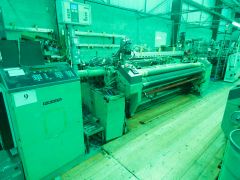 TT-8087 DORNIER RAPIER LOOMS HTVS8, WORKING WIDTH 2200mm, YEAR 1993, DOBBYTT-8087 DORNIER RAPIER LOOMS HTVS8, WORKING WIDTH 2200mm, YEAR 1993, DOBBY 1. DORNIER RAPIER MACHINES 2. BRAND: DORNIER 3. WORKING WIDTH: 2200mm 4. YEAR: 1993 5. TYPE: HTV 8/S 6. DOBBY: STAUBLI 2667 QUANTITY: 2 Learn More
TT-8087 DORNIER RAPIER LOOMS HTVS8, WORKING WIDTH 2200mm, YEAR 1993, DOBBYTT-8087 DORNIER RAPIER LOOMS HTVS8, WORKING WIDTH 2200mm, YEAR 1993, DOBBY 1. DORNIER RAPIER MACHINES 2. BRAND: DORNIER 3. WORKING WIDTH: 2200mm 4. YEAR: 1993 5. TYPE: HTV 8/S 6. DOBBY: STAUBLI 2667 QUANTITY: 2 Learn More
